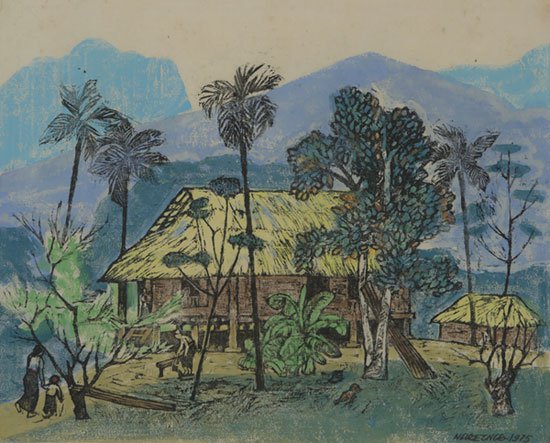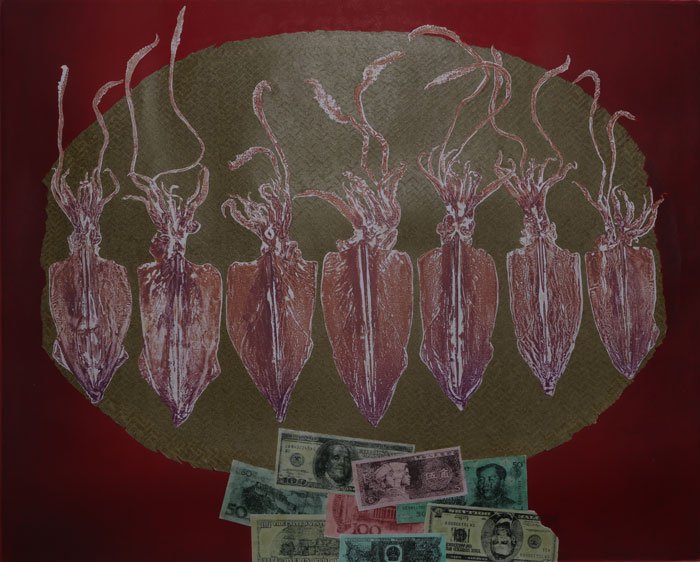|
Collecting art in Vietnam: hidden from view
Art
communities everywhere have big expectations and look forward to collecting
art. However, in

(Thanh Uy
Collection) Nguyet Nga, “The landscape of Hoa Binh”, color wood print, 40x50
cm, 1975
Q. Can you tell us
the reason why you decided to collect art in
I love the arts and always want to
learn and discover what is expressed through each art work. I collect art and
of course I want to collect art from
About the collecting of printmaking
works, including prints and original woodblocks, as well as other print
works, I have three main reasons. First, I feel intuitively that this kind of
artwork is quite suitable for me. I cannot explain further the reason
(laughing). Secondly, print works are reasonably priced, which suits my
financial ability. Thirdly, as far as I know, there is no one in
Q. So I understand
that a budget was an important factor for you to consider before starting
this collection. What are some basic criteria for evaluation of an artwork
for your collection?
Normally the buyer has to base on the
market price, but the local art market in Vietnam doesn’t exist yet, so I
only have two basic criteria, which are based on the most recent price at the
Fine Arts Museum at the time that I was buying, and at the same time I agree
on the price directly with the artists.
Q. I feel that the
criteria of working “directly with the artists” can sometimes be confusing,
for example, how can you come to an agreement when the normal psychology is
that the buyer wants to pay less and the seller wants to get more. In the
process of buying an art work, it requires a certain sensitivity and subtlety
in bidding for the works. I am very curious – have you ever got into any
troublesome situation like that? If so, how can you escape it?

(Thanh Uy
Collection) Le Huy Tiep, “Dry squids and money notes”, mono print, 65x80 cm,
2004
This kind of question actually is
troublesome for me! The pricing of a painting directly with an artist is
always a very sensitive matter because I could hurt the artist’s pride or
they will doubt my knowledge. I must say this kind of work makes me most
confused and hesitant, but it is one of the most important parts of the
collecting process.
Have I ever gotten in any situations
like that? Of course! But luckily, it only ended at the level of my own
personal feelings and there have been no such conflicts with artists at all.
I have experienced certain things in life so that I know how to continue the
story with the artist.
There are some cases, in order to
meet the artist I have to spend lots of time persuading and waiting for them
to see my sincerity. Then again, it takes many stories to finally come to a
specific discussion about some art pieces that I want to purchase… It’s easy
to understand because most of the time, the artist didn’t know who I was, or
what I was like, and they are normally famous artists.
Q. Are there any
other factors that created confusion or tension in collecting work?
There are two more factors. First,
when I first began to collect I didn’t know where to start and how to proceed
with the work. I didn’t know who to ask or where to find information. There
was no one to share and give guidance in the beginning; sometimes I felt that
I was a road detector. Then the time factor sometimes gave me headaches
because I felt like I was consumed by my own collecting and learning process
and at times forgot that I had to do many other things to secure myself
financially to continue collecting works. That’s how it goes!
Q. How many
artworks are there in your collection?

(Thanh Uy
Collection) Tran Nguyen Dan, “
Approximately 1,200 artworks
including prints, gouache drawings and sculptures from 60 Vietnamese artists
and sculptors. I try to choose representative works of each artist from
different periods of Vietnamese art as well as techniques and artistic
styles.
Q. What are your
thoughts on the exchange between different collections and have you ever had
the intention to exchange?
This is a very good idea but really
difficult to implement. I have never done that before, despite my wish. Like
other commodities, the work exchange can only happen when there’s a market,
which publicly announces the price as we’ve just discussed. The market
doesn’t exist in
On the other hand, the number of
people selling and buying paintings is big, but collecting systematically is
still very rare. The tastes and types are quite varied, so there’s no mutual
voice to share the experience as well as exchange art. Previously, I
sometimes shared my collecting work with Le Thai Son and also learned from
him. Sadly he passed away two years ago. At the moment, the selling and
buying of artworks are still done silently, and are not so public; therefore,
private collectors don’t know each other and there’s no chance to meet and
share experiences.
Q. What is your
family’s reaction to your collecting work? Don’t they think that you are
“throwing money out the window”?
People often wonder why I don’t know
how to paint but I know many artists. I work on this quite independently and
my family has almost nothing to do with it. I try to arrange the work so that
it won’t interfere with my family.
Q. What is your
hope for this collection?
I hope in the near future I can
organize thematic exhibitions of the collections, publish books for each
exhibition and finally have a space to showcase those works frequently so
that the audience can come to enjoy and learn more. I believe there are more
and more people loving and wanting to learn more about Vietnamese art.
Thank you very
much!
Phong Van, VNN
Hanoigrapevines
|
Thứ Ba, 17 tháng 3, 2015
Đăng ký:
Đăng Nhận xét (Atom)
Không có nhận xét nào:
Đăng nhận xét